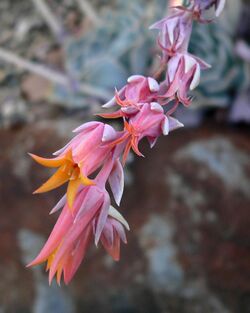Biology:Echeveria runyonii
| Echeveria runyonii | |
|---|---|

| |
| Scientific classification | |
| Kingdom: | Plantae |
| Clade: | Tracheophytes |
| Clade: | Angiosperms |
| Clade: | Eudicots |
| Order: | Saxifragales |
| Family: | Crassulaceae |
| Genus: | Echeveria |
| Species: | E. runyonii
|
| Binomial name | |
| Echeveria runyonii Rose ex E.Walther.[1]
| |
Echeveria runyonii is a species of flowering plant in the family Crassulaceae,[1] that is native to the state of Tamaulipas in Mexico.[2] Several cultivars have been described and cultivated.
Taxonomy and etymology
Joseph Nelson Rose described Echeveria runyonii in 1935,[1] named in honour of Texas amateur botanist Robert Runyon.[3] Runyon had collected the type specimen from a Matamoros, Tamaulipas garden[4] in 1922.[5][6] Wild populations were unknown until 1990, when one was discovered by the staff of Yucca Do Nursery.[7]
The cytology of Echeveria species is helpful in identification, as many species can be very variable in appearance; E. runyonii has 14 chromosomes.[1]
Echeveria is named for Atanasio Echeverría y Godoy, a botanical illustrator who contributed to Flora Mexicana.[8]
Description
Echeveria runyonii forms a rosette 8–10 cm (3.1–3.9 in) in diameter. Leaves are spatulate-cuneate to oblong-spatulate, truncate to acuminate, and mucronate. They are a glaucous pinkish-white in color and measure 6–8 by 2.5–4 cm (2.4–3.1 by 1.0–1.6 in). The single stem reaches 10 cm (3.9 in) in length or more and a diameter of roughly 1 cm (0.39 in). Inflorescences are 15–20 cm (5.9–7.9 in) tall and have 2 – 3 cincinni, conspicuous bracts, and pedicels approximately 4 mm long. The red flowers have ascending-spreading sepals to 11 mm and pentagonal corollas measuring 19 – 20 × 10 mm.[1]
Echeveria desmetiana has similar-coloured glaucous leaves, but its leaves are wedge-shaped with mucronulate (pointed) tips.[9]
Cultivars
Several named cultivars exist, including 'Texas Rose', 'Dr. Butterfield', 'Lucita', 'Tom Allen', and 'Topsy Turvy'. The last is a mutant form originated in California, with leaves positioned upside-down.[10]
Hybrids
- Echeveria 'Domingo' (E. cante × E. runyonii)[11]
- Echeveria 'Green Star' (E. harmsii × E. runyonii 'Topsy Turvy')[12]
- Echeveria 'Swan Lake' (E. shaviana × E. runyonii 'Topsy Turvy')[13]
- Echeveria 'Glade Surprise' (E. derenbergii × E. runyonii 'Topsy Turvy')[14]
- Echeveria 'Dagda' (E. pulvinata 'Frosty' × E. runyonii 'Topsy Turvy')[15]
- Echeveria 'Exotic' (E. laui × E. runyonii 'Topsy Turvy')[16]
References
- ↑ 1.0 1.1 1.2 1.3 1.4 Kimnach, Myron (2003). Urs Eggli. ed. Illustrated Handbook of Succulent Plants. 6: Crassulaceae. Birkhäuser. pp. 103, 122. ISBN 9783540419655.
- ↑ Kimnach, Myron (January 2001). "Three varieties of Echeveria cuspidata". Cactus and Succulent Journal 77 (1): 28–33. doi:10.2985/0007-9367(2005)77[28:TVOEC2.0.CO;2].
- ↑ Eggli, Urs; Newton, Leonard E. (2004). Etymological Dictionary of Succulent Plant Names. Birkhäuser. pp. 207. ISBN 3540004890. https://books.google.com/books?id=u2n5vusQ1DEC&q=Echeveria+runyonii&pg=PA207.
- ↑ Scheick, William (July–August 2012). "Echeverian Beauty among the Rocks". Texas Gardener.
- ↑ "Isotype of Echeveria runyonii Rose, J.N. 1935 [family CRASSULACEAE]". JSTOR. 2011-05-25. https://plants.jstor.org/stable/10.5555/al.ap.specimen.us01014098.
- ↑ "Echeveria runyonii Rose ex E. Walther". Collections Search Center. Smithsonian Institution. http://collections.si.edu/search/results.htm?q=record_ID:nmnhbotany_2164724. Retrieved 2012-07-01.
- ↑ Finkel, Marty (October 2010). "Plant of the month Echeveria 'Topsy Turvy'". The Garden Path. http://vance.ces.ncsu.edu/files/library/91/October%202010.pdf. Retrieved 2012-07-02.
- ↑ Gledhill, David (2008). "The Names of Plants". Cambridge University Press. ISBN:9780521866453 (hardback), ISBN:9780521685535 (paperback). p. 149
- ↑ Cactus and Succulent Society of America (1998). Haseltonia: yearbook of the Cactus and Succulent Society of America, Issues 6-10. p. 81.
- ↑ "RUNYONII Rose ex Walther, 1935.". International Crassulaceae Network. http://www.crassulaceae.ch/index.php?TPL=113&x270_id=1898&x270_listsearch=1. Retrieved 2012-07-01.
- ↑ "Domingo". International Crassulaceae Network. http://www.crassulaceae.ch/index.php?TPL=113&x270_id=499&x270_listsearch=1. Retrieved 2012-07-01.
- ↑ "Green Star". International Crassulaceae Network. http://www.crassulaceae.ch/index.php?TPL=113&x270_id=607&x270_listsearch=1. Retrieved 2012-07-01.
- ↑ "Swan Lake". International Crassulaceae Network. http://www.crassulaceae.ch/index.php?TPL=113&x270_id=2520&x270_listsearch=1. Retrieved 2012-07-01.
- ↑ "Glade Surprise". International Crassulaceae Network. http://www.crassulaceae.ch/index.php?TPL=113&x270_id=2524&x270_listsearch=1. Retrieved 2012-07-01.
- ↑ "Dagda". International Crassulaceae Network. http://www.crassulaceae.ch/index.php?TPL=113&x270_id=471&x270_listsearch=1. Retrieved 2012-07-01.
- ↑ "Exotic". International Crassulaceae Network. http://www.crassulaceae.ch/index.php?TPL=113&x270_id=2391&x270_listsearch=1. Retrieved 2012-07-01.
External links
Wikidata ☰ Q5332387 entry
 |



